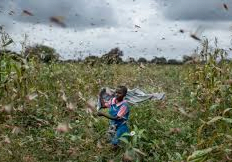Moroccan Locust Attack in Afghanistan
The recent outbreak of the Moroccan locust in Afghanistan has raised concerns about the country’s wheat production and food security. The Food and Agriculture Organization (FAO) has warned that the large-scale infestation across eight provinces could result in significant economic losses and further exacerbate the food insecurity crisis.
Economic Losses and Impact on Wheat Production
The FAO estimates that the Moroccan locust outbreak in Afghanistan’s wheat basket could destroy 700,000-1.2 million tonnes of wheat, accounting for a quarter of the annual harvest. This translates to economic losses ranging from $280 million to $480 million. The locusts pose a significant threat not only to wheat crops but also to more than 150 other plant species, including tree crops and pastures.
Rapid Population Growth
According to the FAO, if no action is taken against the Moroccan locust population, there is a possibility of its multiplication by a factor of 100 within the upcoming year. This alarming growth rate could exacerbate agricultural and food security challenges not only in Afghanistan but also in neighboring countries like Tajikistan, Uzbekistan, and Turkmenistan.
Impacts on Food Security and Famine-Like Conditions
Afghanistan is already facing significant food security challenges, with over 6.1 million people on the brink of famine-like conditions. The country is classified as Phase 4 (emergency) in the Integrated Food Security Phase Classification. The locust outbreak further threatens food security, as it could diminish the wheat supply, a staple crop for many Afghans.
Control Measures and Challenges
To mitigate the locust outbreak, mechanical control methods have been employed, including collecting hoppers and driving hopper bands into trapping ditches. However, Afghanistan’s locust control system has been significantly weakened in the past two years, leading to a shortage of chemical supplies. Urgent funding is required to support both mechanical and chemical control measures and to conduct on-the-ground surveys to monitor and map locust hatching sites.
Month: Current Affairs - May, 2023
Category: International / World Current Affairs


